Pump Handbook by Igor J. Karassik, Joseph P. Messina, Paul Cooper, Charles C. Heald - 3rd edition
Подождите немного. Документ загружается.

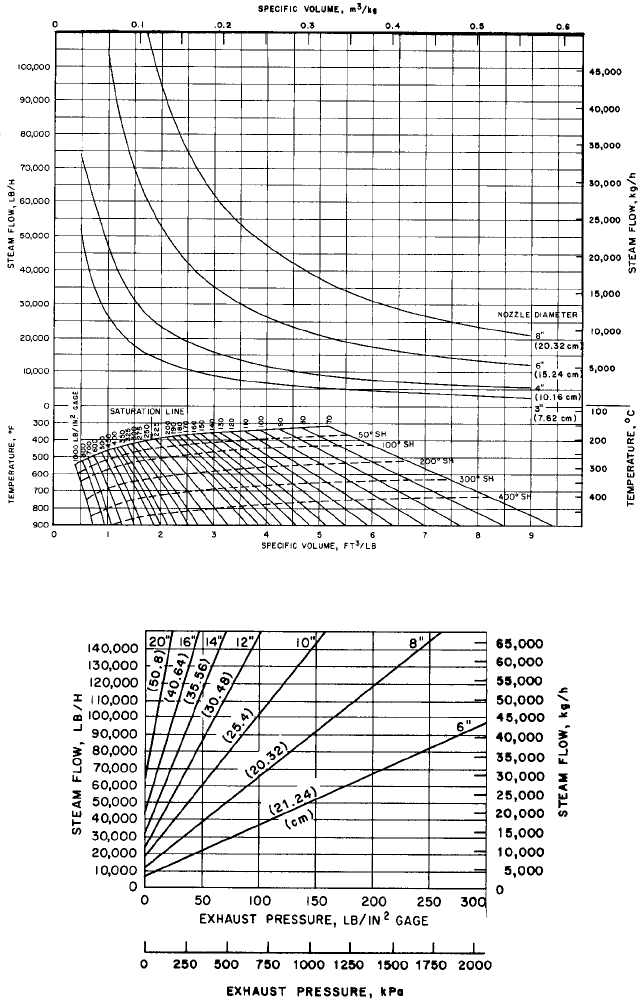
6.1.2 STEAM TURBINES 6.53
FIGURE 10 Nominal inlet flow capacity. Read inlet nozzle size required to pass maximum flow, based on 150-ft/s
(45.7-m/s) steam velocity (lb/in
2
6.895 = kPa; ºF
SH
0.555 = °C
SH
)
FIGURE 11 Nominal exhaust flow capacity. Noncondensing exhaust nozzles, based on 200-ft/s (61 m/s) steam
velocity
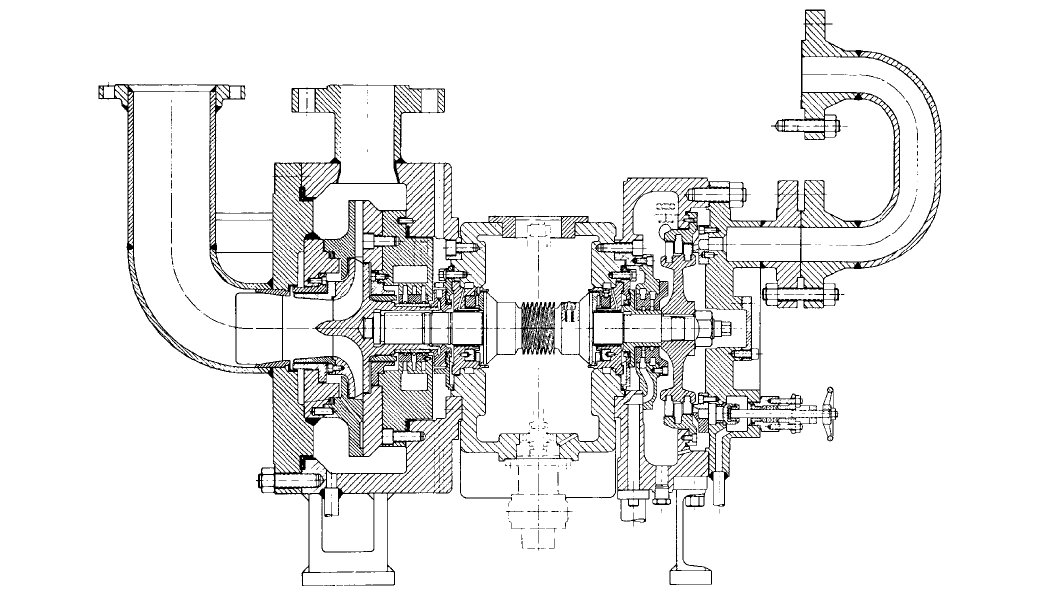
6.54
FIGURE 12 High-speed centrifugal pump and single-stage steam turbine mounted on a common shaft.
Package is designed for boiler feed in marine, industrial, and process steam plants
(Flowserve Corporation).
6.1.2 STEAM TURBINES 6.55
supporting equipment (starters, switch gear, fuel-supply system, and so on), operating
costs, and the initial costs of the various drivers being considered.
REFERENCES _______________________________________________________
1. Church, E. F. Steam Turbines. McGraw-Hill, New York, 1950.
2. “Single-Stage Steam Turbines for Mechanical Drive Service.” NEMA pub. SM22-
1970, 1970.
3. Keenan, J. H., and Keyes, F. G. “Thermodynamic Properties of Steam.” John Wiley &
Sons, Inc., New York, 1936.
FURTHER READING __________________________________________________
Bergeron, W. L. “Governors and Controls: Each Has Specific Operation.” Sugar J.,
March 1965.
“Multistage Steam Turbines for Mechanical Drive Service.” NEMA pub. SM21-1970, 1970.
Skrotzki, B. G. A. “Steam Turbines.” Power special report, 1962.
Steen-Johnsen, H. “Here’s What You Should Know Before You Specify Control Systems for
Mechanical Drive Steam Turbines.” Power Eng., February–March 1966.
Steen-Johnsen, H. “How to Estimate the Size and Cost of Mechanical Drive Steam Tur-
bines.” Hydrocarbon Processing, October 1967.
Steen-Johnsen, H. “Mechanical Drive Turbines.” Oil Gas Equip., March, April, May, 1967.
Steen-Johnsen, H. “Selecting the Right Steam Turbine for Industrial Use.” Power Eng.,
April 1965.
“Theoretical Steam Rate Tables.” ASME, 1969.
6.1.3
ENGINES
F. J. GUNTHER
6.57
ENGINE SELECTION AND APPLICATION _________________________________
The internal combustion engine is used extensively as a driver for centrifugal and
displacement pumps. Depending on the application, the engine fuel may be gasoline, nat-
ural gas, liquid petroleum gas (LPG), sewage gas, or diesel fuel. It may be either liquid-
or air-cooled.
Basic Design Variations The basic design of the engine may vary. The cylinder block
construction is vertical or horizontal, in-line or V-type. The number of cylinders ranges
from 1 to 20. The engine cycle is either four (one power stroke in two revolutions of the
crankshaft) or two (one power stroke in one revolution of the crankshaft). The combustion
chamber and cylinder head design are classed as L-head (valves in the cylinder block) or
valve-in head. In the diesel engine, the combustion chamber may be of the precombustion
chamber design, where an ante chamber is used to initiate combustion, or of the direct
injection design, where the fuel is injected directly into the cylinder. The piston design
action may be vertical, horizontal, at an angle as in the V-type engine, or opposed piston
(two pistons operating in the same cylinder).
Power Ratings The power range of engines in current production, depending on dis-
placement, number of cylinders, and speed, is as follows:
1. Air-cooled gasoline, natural gas, and diesel: 1.0 to 75 hp (0.75 to 56 kW)
2. Liquid-cooled gasoline: 10 to 300 hp (75 to 224 kW)
3. Liquid-cooled natural gas, LPG, and sewage gas: 10 to 15,000 hp (75 to 11,200 kW)
4. Liquid-cooled diesel: 10 to 50,000 hp (75 to 37,300 kW)
5. Dual fuel, natural gas, LPG, and diesel: 150 to 25,000 hp (112 to 18,700 kW)
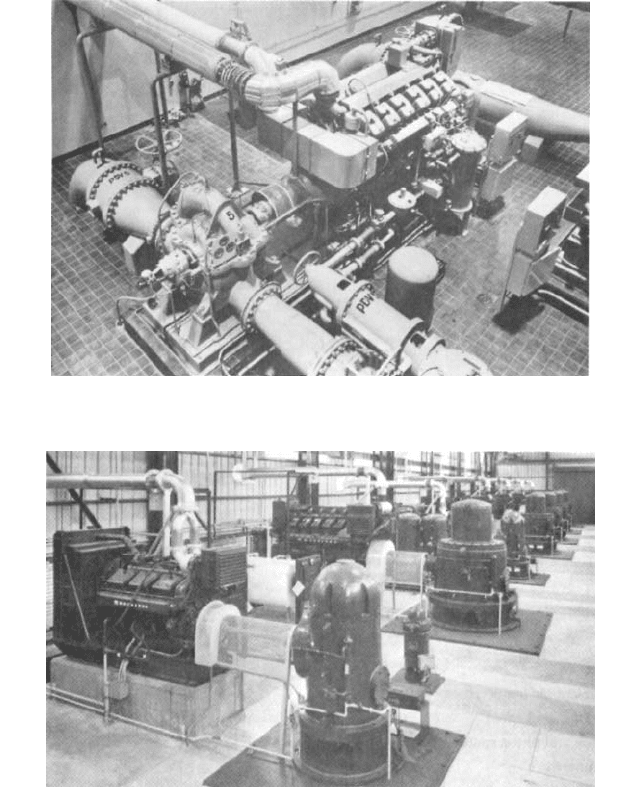
6.58 CHAPTER SIX
FIGURE 1 Natural gas engine driving a horizontal water pump for Winnipeg, Canada, water utility (Waukesha
Motor)
FIGURE 2 Diesel engine driving pumps for flood-control station in Seattle (Waukesha Motor)
Typical engine driver applications are represented in Figures 1 and 2.
The rating of the internal combustion engine is the most important consideration in
making the proper selection. The general practice is to rate engines according to the sever-
ity of the duty to be performed. The most common rating classifications are maximum,
standby or intermittent, and continuous.
The maximum output is based on dynamometer tests that are corrected to standard
atmospheric conditions for temperature and barometric pressure. In applications, this power
rating is reduced by accessories such as cooling fans, air cleaners, and starting systems.
Standby, or intermittent, and continuous ratings are arrived at by applying a percent-
age factor to the net maximum power rating. For example, 75 to 80% is used for continu-
ous and 90% for intermittent.

6.1.3 ENGINES 6.59
Duty cycle is a term used to describe the load pattern imposed on the engine. If the load
factor (ratio of average load to maximum capabilities) is low, we call the duty cycle “light,”
but if it is high, we classify the cycle “heavy.” Continuous, or heavy-duty, service is gener-
ally considered to be 24 h/day, with little variation in load or speed. Intermittent service is
classified as duty where an engine is called upon to operate in emergencies or at reduced
loads at frequent intervals.
In analyzing power problems when selecting a proper engine, certain terms are used
in the industry:
DISPLACEMENT The displacement in cubic inches (cubic centimeters) of an engine cylinder is
In USCS units,
In SI units
Torque The twisting effort of the engine in pound-feet (Newton-meters) is
In USCS units
In SI units
ENGINE POWER
This is a measure of the theoretical characteristics of an engine. Brake
horsepower (bkw) is the measurable power after the deduction for frictional losses:
In USCS units
In SI units
BRAKE MEAN EFFECTIVE PRESSURE The average cylinder pressure to give a resultant torque
at the flywheel in pounds per square inch (kilopascals)
In USCS units
In SI units
PISTON SPEED At a given speed, the average velocity of piston in feet per minute (cen-
timeters per minute) is
In USCS units
In SI units
In selecting an engine for a particular application, the following variables should be
considered:
• Altitude
• Ambient air temperature
Piston speed stroke 1cm2 2
rpm
6000
Piston speed stroke 1in2 2
rpm
12
bmep
60 10
6
bkW
rpm D
1two cycle2
bmep
120 10
6
bkW
rpm D
1four-cycle2
bmep
396,000 bhp
rpm D
1two cycle2
bmep
792,000 bhp
rpm D
1four-cycle2
bkW T
rpm
9545
bhp T
rpm
5252
T 9545
bkW
rpm
T 5252
bhp
rpm
D bore 1cm
2
2 0.7854 stroke 1cm2 no. of cylinders
D bore 1in
2
2 0.7854 stroke 1in2 no. of cylinders

6.60 CHAPTER SIX
• Rotation and speed
• Bmep and piston speed
• Maintenance
• Type of fuel
• Operating atmosphere (dust and dirt)
• Vibrations and torsionals
• Engine pollutants
The observed power is that produced by an engine at the existing altitude and tem-
perature. All engine manufacturers publish power ratings corrected to certain conditions;
for conditions other than these, it is necessary to correct by applying a percentage factor
for altitude and temperature. Generally this is 3 % per thousand feet (305 m) above sea
level and 1% for every 10°F (5.6°C) above 60°F (50.4°C). In a turbocharged engine, there
is no established standard and the engine manufacturer should be consulted.
The basic rotation of engines in current production is counterclockwise when viewed
from the flywheel end of the engine, although many of the larger engines are available in
both counterclockwise and clockwise rotation.The speed of the engine is generally fixed by
the equipment being driven. Through the use of speed-increasing or -reducing gear boxes,
the proper engine for a given application may be selected. A gear box may also be used to
correct a rotation problem.
Speed ranges for engines generally fall into three categories:
• High
—
above 1500 rpm
• Medium
—
700 to 1500 rpm
• Low
—
below 700 rpm
High-speed engines generally offer weight and size advantages as well as cost sav-
ings and thus are used for standby applications. On the other hand, medium- or low-
speed engines, although heavier and larger, offer a gain in service life and lower
maintenance costs.
The speed flexibility of an engine drive is important when the engine is to be used to
drive a pump that must move variable quantities of liquid. The engine speed may be
changed very simply either manually or through the use of liquid or pressure controls.
Bmep is generally a measure of load, and piston speed a measure of potential wear and
maintenance. Although the introduction of the turbocharged and intercooled engine has
somewhat changed the consideration given these factors, it is still important to consider
them in selecting engines where long life is a factor.
Maintenance of engines has been considered by some as objectionable and more costly
than electric power. A recent innovation of engine manufacturers, in the form of a service
contract for installations where trained personnel are not available or desirable for eco-
nomic reasons, can eliminate these objections and costs. The complete maintenance of the
engine is done on a fixed-fee basis for a designated period of time.
The exhaust gases of spark ignition and compression ignition (diesel) engines contain
pollutants that for many engine applications are increasingly the subject of legislation
restricting the quantity of pollutants the engine can emit. Examples of pollutants are car-
bon monoxide (CO), oxides of nitrogen (NOx), unburned hydrocarbons (HC), and, for
diesels, particulates in the form of carbon soot. Pollutants can be measured on a specific
basis, such as g/bhp-hr and ppm (parts per millions by volume), or on a site basis, such as
lb/hr or tons/year. Engine manufacturers are designing “clean” engines that incorporate
features to minimize the formation of pollutants during combustion and may include cat-
alytic converters and particulate fibers in the exhaust system to further reduce the pollu-
tants emitted in the exhaust gases.
The remaining conditions listed previously will be discussed in detail later.
1
2
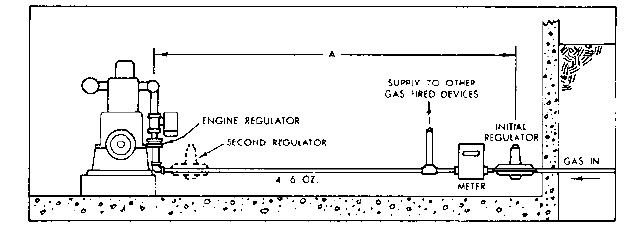
6.1.3 ENGINES 6.61
FIGURE 3 Typical natural gas fuel system (Waukesha Motor)
FUEL SYSTEMS______________________________________________________
Gasoline
Gasoline is used primarily with standby pumping units. Inasmuch as the
spark ignition system first introduced the internal combustion engine to power applica-
tions, gasoline was used as the primary fuel. Commercial gasoline has an average heat-
ing value of 19,000 Btu/lb (44.2 MJ/kg). It is easy to transport and handle and, unlike
gaseous fuels, does not require pressure storage and regulating equipment. The starting
capabilities of a gasoline engine are satisfactory, provided the engine is in good operating
condition. With the high-power engine of today, refinery control can produce a fuel
matched to the operating conditions.
Gasoline does have some disadvantages that are reducing its use as an engine fuel. In
small-volume usage, it is safe and easily handled. In larger volumes, it becomes expensive
and hazardous. Because it is not entirely stable, it will deteriorate when exposed to gums
and resins in storage over a period of time. There is also the possibility of condensation of
water in the fuel, which is detrimental to good operation. The danger of fire is always pre-
sent because of leaks in the system. Finally, the increased production and distribution of
gasoline have made it a target of increasing taxation, making it economically prohibitive
in many installations.
Gas A gaseous fuel system using natural gas, LPG, or sewage gas may be a simple man-
ually controlled system, such as a gasoline engine, or a carefully engineered automatic
system. The basic gas carburetion system consists of a carburetor and pressure regulator
mounted on the engine. A gas distribution system, like a water supply system, must be at
some designated pressure and flow, and so a field pressure regulator is required.The char-
acteristics of this regulator will depend upon the gas analysis, the displacement of the
engine, the speed range, and local regulations. A typical schematic of a gas fuel system is
shown in Figure 3. The location of the regulator is generally under the jurisdiction of the
gas utility that supplies it. In most cases, a single field regulator is all that is required,
but at times this can cause problems. For example, subsequent installation of gas-burning
equipment used intermittently may cause gas pressure regulation not compatible with the
small amount required for pilot lighting. A single regulator installed some distance from
the engine could result in hard starting because the engine vacuum is not sufficient for a
full gas flow. To eliminate this problem, the initial regulator is set at a higher pressure in
order to give a readily available supply of fuel for all devices.
Natural gas has an average heating value of 800 to 1000 Btu/ft
3
(29.8 to 37.3 MJ/m
3
).
Commercial butane has a value of 2950 Btu/ft
3
(110 MJ/m
3
), and propane a value of 3370
Btu/ft
3
(126 MJ/sn
3
). Commercial LPG fuel, which is a mixture of butane and propane,
varies in both amount and corresponding heating value.
LPG fuel is produced by mechanical and compression processes, and the methods of
distribution and handling must meet regulations. Natural gas is usually supplied under
moderate pressures, seldom exceeding 50 lb/in (345 kpa), whereas LPG fuel is supplied as
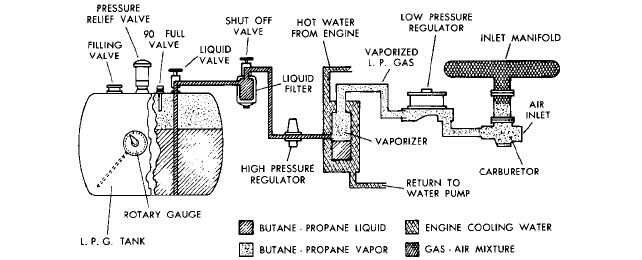
6.62 CHAPTER SIX
FIGURE 4 Typical LPG fuel system (Waukesha Motor)
a liquid under pressures as high as 200 lb/in
2
(1380 kPa) in warm weather. As a result, nat-
ural gas will readily mix with air and burn, whereas LPG fuel must be changed from a liq-
uid to a vapor with the addition of heat, as shown in Figure 4.
As a natural process in the modern waste-treatment plant, sewage gas may be pro-
duced in the sewage digester. This gas has the same basic qualities as natural gas and is
composed of about 65 to 70% methane. It has a heating value of 550 to 700 Btu/ft
3
(20.5 to
26.1 MJ/m
3
). The same basic carburetion system used for natural gas is used. Sewage gas
contains inert substances, particularly hydrogen sulfide or free sulfur, which in the pres-
ence of free moisture or moisture resulting from combustion will form sulfurous acid,
which is corrosive and thus damaging to the valves, pistons, and cylinder walls of an
engine. An engine can tolerate from 10 to 30 g of sulfur per 100 ft
3
(350 to 1100 g per 100
m
3
). Beyond this, a filtering system to remove the sulfur and moisture is advisable.
Diesel The diesel engine over the years has been used for larger power systems. The
initial cost of the system is justified to an extent by lower cost of the fuel. The better fuel
economy of the diesel engine and its torque characteristics also are important factors in
the selection of this fuel for many applications. Diesel fuel has one distinct advantage: it
does not form the dangerous fuel vapors that other fuels do. It does require, however, a
good fuel-filtering system because of contaminants in the fuel that can create problems
for the precision design of the fuel-injection system.
Commercial diesel fuels are the residue that remains after the more volatile fractions
of crude oil have been removed. The heating value is generally about 19,000 Btu/lb (44
MJ/kg). In the diesel engine, the fuel is injected into the cylinder at the end of the com-
pression stroke in an atomized form. The compression stroke results in a temperature suf-
ficient to ignite the fuel without the use of any ignition device.Although fuel systems from
different engine manufacturers vary, the basic components are the same.
The larger diesel engines may be designed to operate on a dual fuel system.The engine
operates on five gaseous fuels with a pilot injection of diesel fuel for ignition. In case of a
loss of the gaseous fuel supply, the engine will convert to 100% diesel fuel.
Relative Performance Curves Typical performance curves comparing power, torque,
and part-load fuel economy are shown in Figure 5.
COOLING SYSTEMS __________________________________________________
Cooling is essential in all internal combustion engines because only a small portion of the
total heat energy of any fuel is converted to useful energy. The remainder is dissipated into
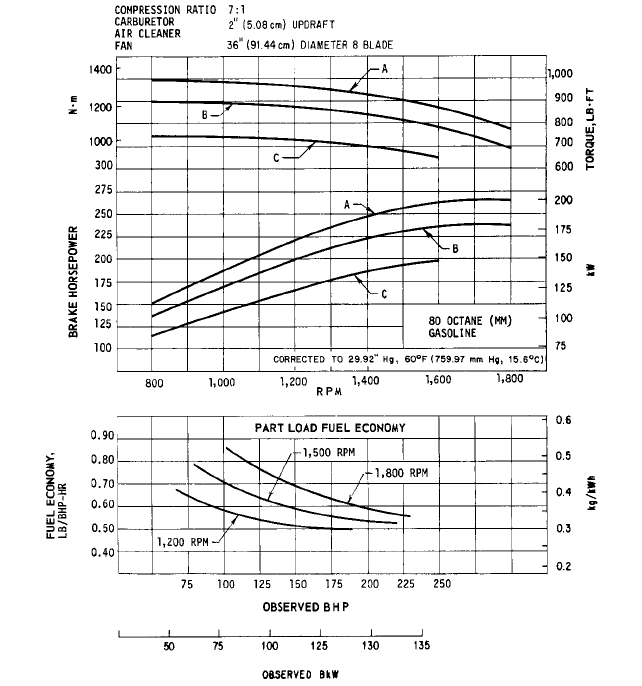
6.1.3 ENGINES 6.63
FIGURE 5A Gasoline engine performance curves: (A) maximum, (B) intermittent, (C) continuous ratings of
engines with accessories (Waukesha Motor)
the coolant, exhaust, and lubricating oil and by radiation. A hypothetical heat balance is
shown in Figure 6.
Specific data and recommendations on cooling requirements vary from one manufac-
turer to another. In general, the heat rejection to an engine cooling system will range
between 30 to 60 Btu/hp min (25 to 51 MJ/kWh) for diesel engines and up to 70 Btu/hp
min (59 MJ/kWh) for natural gas and gasoline engines. This heat must be transferred to
some form of heat-exchange medium.
In designing any cooling system, certain factors must be considered:
• Additional heat from driven equipment, such as the cooling of speed-reducing or
-increasing gears where the engine coolant is the medium
• Water-cooled exhaust manifolds on the engines or water-cooled exhaust turbochargers
or after-coolers
• High ambient temperatures or heat from nearby equipment
